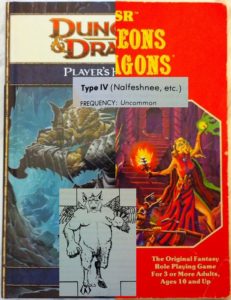The request I got:
Dear Secret Santicore…
I’d like a table or set of tables for generating weird cults.
Thanks!
And here it is.
MARK II WEIRD CULT GENERATOR
(Use with caution. Service all parts every 30 days.)
Roll 10d10 and consult the tables in order.
Or, roll d10 for the number of tables to consult (let N be this number), and then roll Nd10 to decide which tables to consult and another Nd10 to determine the operative values.
Never, ever, roll on the animal table unless explicitly directed to by another table. Otherwise, bad things will happen. We don’t talk about what happened to those who used MARK I. Just be glad you got MARK II.
TABLE I: What do they worship?
- The idea of progress
- A demon lord
- The jealous, forgotten god of the chosen people
- Prince of animals (roll on animal table)
- The lord of Nod, the land of sleep and hallucination
- Deposed deified emperor from 1000 years ago (“Dark Augustus”)
- The universal life-force
- The new prophet
- Overlord of a rival state
- An ancient machine
TABLE II: What is their identifier?
- Animal tattoo on their back (roll on animal table)
- Fine silver ring, allowed to tarnish
- Ritual cross-hatch scars on upper arms
- Glass eye
- Secret handshake
- Green blood
- Nictitating eyelid
- Sharp teeth (either sharpened or naturally sharp)
- Hairless
- Verbal prayers of thanks to the patron upon any success
TABLE III: What is their ultimate goal?
- Extinction, but they want to take as many others with them as possible
- Accumulate souls for their account in hell
- To take back the underworld — men belong underground, monsters above
- Prepare the world for the ancient masters from the stars
- Immortality; each cell has part of the recipe, they seek each other out
- Enlightenment through extreme experiences
- Reforesting the great waste known as civilization
- Yellow is the sacred color, as much of the world as possible must be in this hue
- The end of warfare
- Reuniting two sundered worlds
TABLE IV: Who is in charge?
- Mad charismatic crackpot
- Demon, fae, or otherworldly being in human guise
- Explorer who found the fountain of youth
- Swindler, bilking the credulous
- Swindler, bilking the credulous, unaware that his teachings are true
- Ancient underground machine
- Prince of animals (roll on animal table for type)
- One of the PCs in a past life or before the amnesia
- An animate painting
- A telepathic idol of the ancients
TABLE V: What is their taboo?
- Must not eat vegetables
- Will not shake hands (it is polluting)
- If you meet their eyes, you will learn one of their secrets
- They must wash skin that sunlight touches
- Dead cultists must be ritually separated in buried in 6 different locations
- Must not start a fire
- Sexual abstinence
- Will eat nothing cooked
- Must not lie
- Must always have a clear mind; no intoxicants
TABLE VI: What is their secret power?
- Start and control fires — pyrokinesis
- Corpses speak to cultists
- Discipline of the body — ancient martial arts
- Preserve corpses indefinitely, either magically or scientifically
- None, though they believe they can summon demons
- Rust metal by touch
- Mind meld — they can read thoughts by touch
- Fertile — crops tended yield 2 to 3 times normal bounty
- Sympathetic magic — voodoo that works
- Influence animals (like the cleric’s turn undead ability)
TABLE VII: What is their ritual garb?
- Yellow robes
- Full armor with helm (antiques valued)
- Official magistrates — they actually run the
- Wizard robes, full on stars and moons and pointy hats (they believe they are magic-users)
- Finely scented loin cloth
- Black tunic and sandals
- Masquerade masks
- Business formal — suit and tie or equivalent for time period
- Paramilitary uniforms
- Shape-changers — lycanthropes or other, ritual “garb” is their non-human form
- Eating live animals (roll on animal table for type)
- Recitation of ancient sutras
- Silent meditation
- Ritual combat
- Human sacrifice
- Animal sacrifice (roll on animal table)
- Burning the sacred texts of rival cults
- Riddles
- Summoning
- Believer suicides
TABLE IX: Where do they hold their nameless rituals?
- Center for performing arts (amphitheater, boxing ring, etc)
- Ancient stone circle
- Fake ancient stone circle (they set it up)
- Ancient unearthed vessel
- Town hall — they run the place
- The home of a ritually slain family
- A natural glade under an overcast sky
- By running water to protect from hostile spirits
- Another religion’s holy sanctum
- In the northeast of any habitation
TABLE X: How old is the sect?
- Just founded last week
- Before any known civilization
- Was loosed on the world by something let out of a dungeon by PCs
- During the founding of the current dynasty (or political order)
- The previous dynasty (cult is all that remains)
- Cult is a cyclical plague unleashed to punish decadent societies
- Originally founded by a demigod during the creation wars
- Older than written history (all cult records are oral)
- It was born with the leader and will die with the leader
- Founded based on some past innocuous PC action
APPENDIX: Animal table
- Mantis
- Turtle
- Ram
- Wasp
- Ox
- Peryton
- Worm
- Cat
- Lizard
- Centipede


